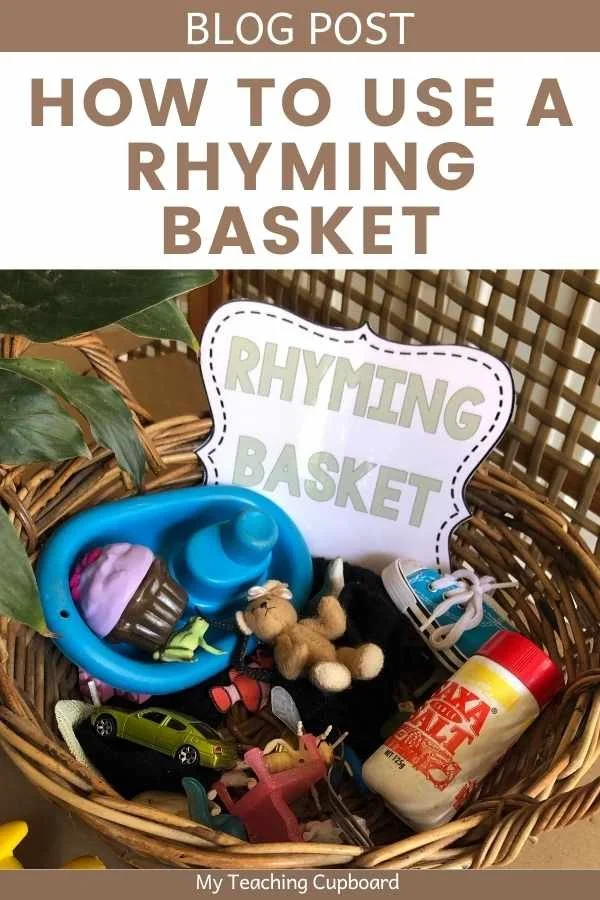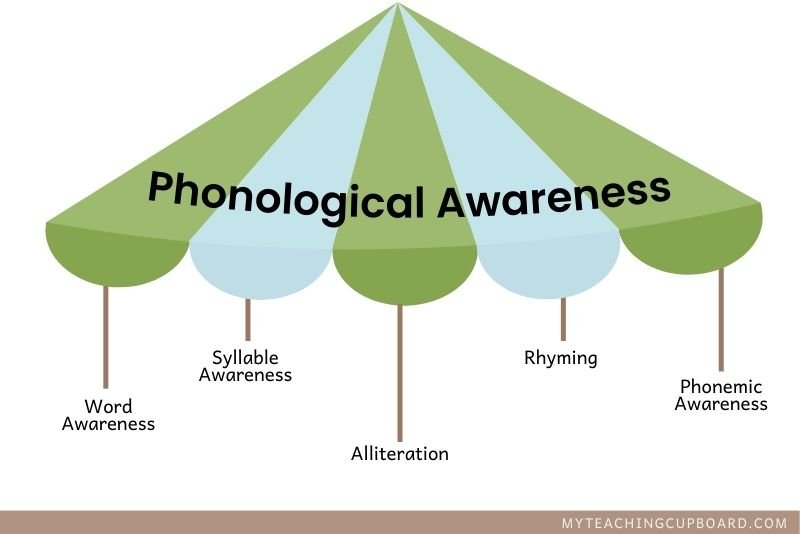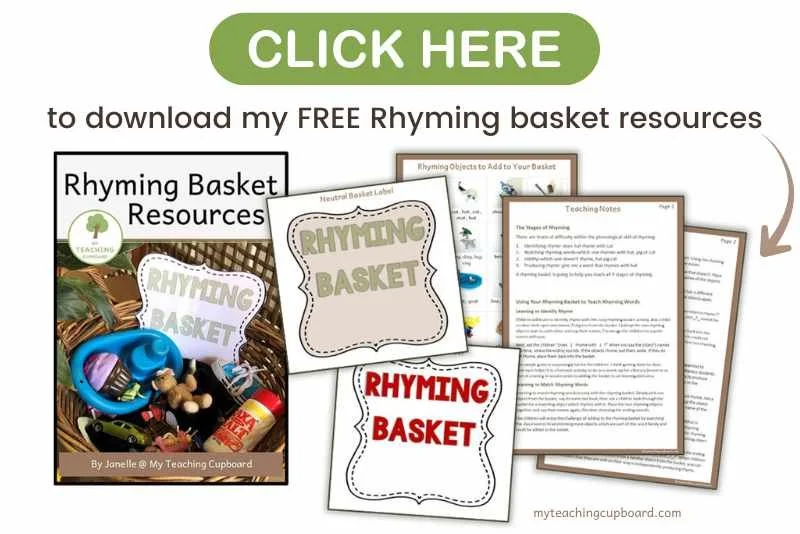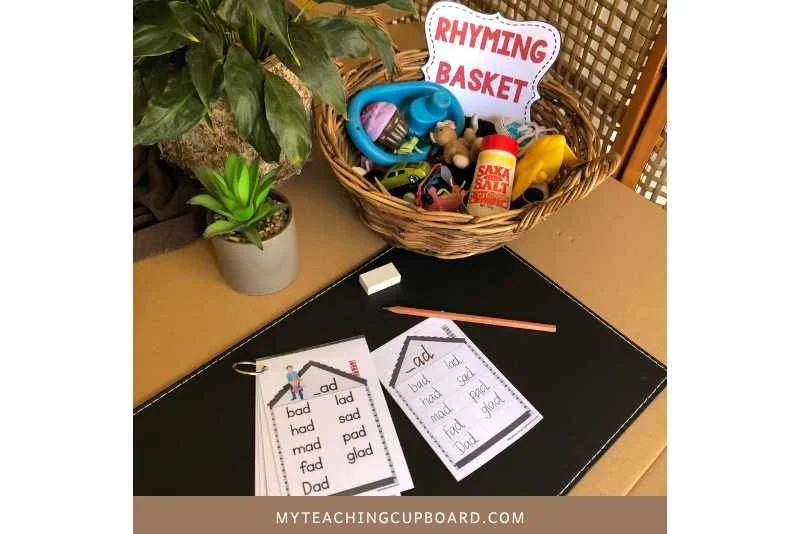Use a Rhyming Basket to Teach Rhyming Words
Discover how to teach rhyming words with a playful rhyming basket activity. Perfect for kindergarten, this hands-on rhyming basket idea builds rhyming skills for phonological awareness.
Are you learning about rhyming words in your classroom?
Looking for a fun activity to help your students learn to rhyme?
A rhyming basket just may be the answer.
Adding a rhyming basket is a great way to introduce rhyme through hands-on play. Without worksheets! You can use it alongside nursery rhymes, a rhyming book, or even in imaginative play. It works beautifully in small groups and adapts to any child’s ability level.
Rhyming and Phonological Awareness
Phonological Awareness is a broad umbrella term for the awareness of what sounds are and how these sounds work together to make words.
Some research suggests phonological awareness has no apparent developmental sequence, but I don't agree. In my experience, some elements of phonological awareness seem to be more difficult than others for kindergarten children to master. For example, young children can often split words into onsets and rimes much more easily than they can manipulate the individual phonemes (sounds) within words.
Rhyming along with the ability to segment words and identify the sounds within words are subskills of phonological awareness. Rhyming is just one of the foundational skills children will need in order to become capable readers and writers. When children understand rhyming, they will notice familiar word families and similar sounds. The awareness of spelling patterns and word family structures helps beginning readers decode effectively and beginning writers spell correctly.
Phonemic awareness also develops as children practise rhyme. In my classroom, hearing the ending sound in words, noticing new words that rhyme, and playing rhyming games have all contributed to stronger early literacy outcomes.
The Stages of Rhyming
There are levels of difficulty within the phonological skill of rhyming.
Identifying Rhyme–"Does hat rhyme with cat?"
Matching Rhyming Words–"Which one rhymes with hat? Pig or cat?"
Rhyme Oddity–"Which one doesn’t rhyme? Hat, pig or cat?"
Producing Rhyme–"Give me a word that rhymes with hat."
A rhyming basket is going to help you teach all 4 stages of rhyming.
Each stage gives us insight into a child’s ability to notice similar sounds and generate a correct answer. Teachers can use these skills as informal assessments when planning for the next step in a child’s learning journey.
Why Learning Rhyming Words Matters
Rhyming is not only fun for little ones. It is also a powerful early literacy skill. When young learners recognise word families and hear similar sounds, they begin to understand how words work. This awareness builds confidence in both reading and writing.
If a child can spell “cat,” then they can also write “bat, hat, mat, rat, fat.” Knowing how to use rhyming words gives kids a strategy for spelling new words and helps them notice spelling patterns. Rhyming also supports language development, strengthens memory, and makes reading and writing so much easier.
👉 If you’d like to learn more about teaching rhyme, phonological awareness, and phonemic awareness, download my FREE Guide to Phonological and Phonemic Awareness. It’s packed with practical tips, examples, and activities that show you the best way I’ve found to teach all these important skills in the classroom.
This free guide is the perfect companion to your rhyming basket activities. It gives you the background knowledge and practical strategies you need to feel confident teaching rhyme in fun, hands-on ways.
What is a Rhyming Basket?
A rhyming basket is simply a collection of small rhyming objects placed into a basket. Using small manipulatives to learn about rhyming words promotes hands-on learning. Children learn best when they are touching and doing. Using hands-on manipulatives is so much more effective than a worksheet or a set of rhyming pictures.
While rhyming pictures can still be used, real objects provide a stronger sensory experience. Everyday items, miniature farm animals, toys, or loose parts can become powerful rhyming objects. Using everyday items connects rhyme to real life, supporting both language development and fine motor skills when children handle the objects.
All teachers know hands-on learning is extremely beneficial in the early childhood classroom. When children learn by doing, they are engaged and learning with their hands and their minds. Your young learners will be much more focused and motivated to learn when you keep the learning experiences hands-on.
There are many learning opportunities where you can use a rhyming basket in your classroom.
Add it to an investigation area.
Use it as a resource in explicit teaching lessons.
Add it to your classroom library shelf.
Turn it into an activity at a literacy centre.
What to put in a Rhyming Basket
You will find many small rhyming objects around your home and classroom. Think about your small world play resources and your collection of loose parts. I often check out the little miniatures available in the discount stores too.
I have compiled a comprehensive list of easy to find rhyming objects for you to add to your rhyming basket. You can download the list HERE in my FREE Resource library.
Here are just a few ideas to get you started: man and pan, chair and bear, snake and cake, cat and hat, duck and truck, car and star.
TIP: Adding rare words or mixing in a recording sheet where children can draw the object’s names and practise writing can add another layer to the learning.
Using a Rhyming Basket to Learn Rhyming Words
Now that you know the stages of rhyming, let’s look at how a rhyming basket can bring them to life in your classroom. The beauty of this simple learning resource is that it can adapt to every stage of rhyming - whether your children are just beginning to hear similar sounds or are ready to create a new word on their own.
In this next section, I’ll walk you through how to use your rhyming basket to cover each of the four stages of rhyming (with practical ideas you can try straight away).
Learning to Identify Rhyme
Children will learn to identify rhyme with this easy rhyming basket activity. Ask a child to close their eyes and choose 2 objects from the basket. Hold up the two rhyming objects next to each other and say their names. Encourage the children to say the names with you.
Next, ask the children “Does _1_ rhyme with _2_?” When you say the object’s names, stress the ending sounds. If the objects rhyme, put them aside. If they do not rhyme, place them back into the basket.
This simple game is surprisingly fun for the children. I think getting them to close their eyes helps! It is a fantastic activity to do as a warm-up for a literacy lesson or as part of a tuning-in session prior to adding the basket to an investigation area.
This is an easy activity to set up, yet it provides a powerful foundation for early literacy skills.
Learning to Match Rhyming Words
Learning to match rhyming words is easy with a rhyming basket. Simply pick one object from the basket, say its name out loud, then ask a child to look through the basket for a matching object which rhymes with it. Place the two rhyming objects together and say their names again, this time stressing the ending sounds.
The children will enjoy the challenge of adding to the rhyming basket by searching the classroom or brainstorming more rhyming objects, which are part of this word family and could be added to the basket.
This rhyming match activity encourages children to build a rhyming pair, helping them practise hearing similar sounds while strengthening their awareness of what sounds make words rhyme.
Learning about Rhyme Oddity
Learning about rhyme oddity is sometimes a difficult task for young children. Using the rhyming basket and the rhyming objects seems to make it a little easier.
Choose three objects from the basket–two that rhyme and one that doesn’t. Place the three objects in a line. Encourage the children to say the names of the objects with you as you point to each object.
Next, ask the children “Which one does not belong? Which one has a different ending sound?” After their response, say the names of the three objects again, stressing the ending sounds again.
You might like to continue with more questioning. Ask “Which two objects rhyme?” Repeat their response, stressing the ending sounds. Ask “Do _1_ and _2_ sound the same at the end?”
If the children selected the oddity correctly, place all three objects back into the basket and continue the game with three new objects. If the children could not correctly select the rhyming oddity, you might need to re-visit the first two rhyming skills of identifying and matching rhymes.
This step requires careful listening and often a bit of scaffolding. It’s one of the best activities for developing listening accuracy and teaching children to choose the correct answer when they compare object’s names.
Learning to Produce Rhyme
The last level of difficulty within the phonological skill of rhyming is learning to produce rhyme. This level is an important level for teachers of early literacy students. If you are implementing the Australian curriculum, requiring students to produce rhyme is part of the ACARA curriculum assessment pieces for children in the Foundation Stage.
Use your rhyming basket to teach your kindergarten children to produce rhyme. Ask a child to close their eyes and choose one object from the basket. Hold up the object and encourage the children to say the object’s name with you. Say the name of the object again, stressing the ending sound.
Next, ask the children to produce a rhyming word for this object. Say, “ What is another word which rhymes with object?” If you have been using the rhyming basket regularly with your class, you might find the children remember the rhyming objects within the basket. Instead of independently producing a rhyming word, they may give you the name of the matching rhyming object from memory.
This is OK! You can then say the names of the two objects, again stressing the ending sounds. Ask “What is another word which rhymes with _1_ and _2_?” When children can give you a rhyming word which is not a familiar object from the basket, you can be confident that they are well on their way to independently producing rhyme.
Producing rhyme supports oral fluency, vocabulary growth, and the ability to transfer patterns to a new word. This is where rhyme links beautifully to both phonemic awareness and phonics instruction.
Phonological Awareness is NOT about Writing
You may have noticed the objects in the rhyming basket sound the same but don’t always have the same spelling patterns. Phonological awareness is purely an auditory activity. Phonological Awareness is NOT about Writing. The purpose of these rhyming basket activities is to develop phonological awareness skills.
Phonics is the term given to sounds as graphemes (written alphabet letters) or morphemes (written prefixes and suffixes). When children learn phonics, they represent the auditory sounds with the corresponding visual representations or alphabet letters.
Phonics is about the visual representation of sounds, while phonological awareness is about the auditory representation. The activities in this blog post use the rhyming basket to teach children to hear and match sounds.
You could easily transform these activities into writing and reading activities if you feel your children are ready for the next step.
When your children are ready for phonics and writing, you could create a recording sheet where they can draw the rhyming pair and write the object’s names. This extends the fun activity into a literacy-rich experience without losing its playful nature.
Want more help teaching rhyming words? I have another blog post I think you’ll like. Teaching Rhyming Words has more strategies and tips. It’s packed with rhyming games, activities, and hands-on resources that make rhyme practice fun and effective.
Teaching rhyme doesn’t have to be another thing on your never-ending to-do list. I know how tricky it can be to keep young children engaged, meet curriculum outcomes, and still make learning feel like a fun activity.
That’s why I’ve created ready-to-go tools to make your job easier.
👉 So - don’t forget to grab my FREE Rhyming Basket Printables from the Resources Library. They’ll save you time thinking up rhyming word ideas and give you a handy list of words and rhyming objects to start with.
And if you’re ready for even more support, check out all of my hands-on rhyming activities in the store.
They’re designed to take the stress out of teaching rhyme and give your students fun, meaningful practice with word families, matching rhymes, and playful rhyming games.
You don’t have to figure it all out alone. I’ve tried and tested all the activities in my library and store and I'm so happy to share them with you. Check them out and get some of your planning time back... and get ready to watch your students grow in confidence with rhyming too!
Just some of the products you might be interested in..
If you found this post useful, please consider sharing it…















